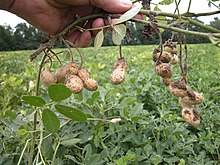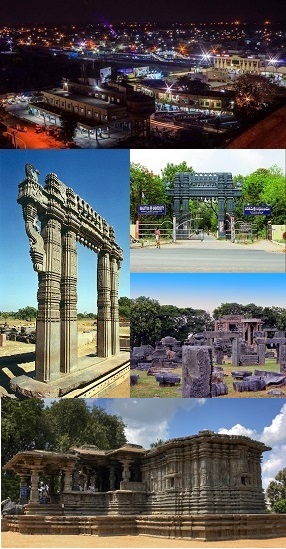
Warangal is a city in the Indian state of Telangana and the district headquarters of Warangal district. It is the second largest city in Telangana with a population of 704,570 per 2011 Census of India, and spreading over an 406 km2 (157 sq mi). Warangal served as the capital of the Kakatiya dynasty which was established in 1163. The monuments left by the Kakatiyas include fortresses, lakes, temples and stone gateways which, in the present, helped the city to become a popular tourist attraction. The Kakatiya Kala Thoranam was included in the emblem of Telangana by the state government and Warangal is also touted as the cultural capital of Telangana.

Mothkur is a Municipality and also a mandal headquarter situated in Yadadri Bhuvanagiri district in the Indian state of Telangana.It is also a Taluka ertswhile. Mothkur is located 100 kilometers away from the Telangana's capital city, Hyderabad.

The Kakatiya dynasty was a Telugu dynasty that ruled most of eastern Deccan region in present-day India between 12th and 14th centuries. Their territory comprised much of the present day Telangana and Andhra Pradesh, and parts of eastern Karnataka and southern Odisha. Their capital was Orugallu, now known as Warangal.

Hanumakonda is a major city and the district headquarters of Hanumakonda district in the Indian state of Telangana.Earlier Hanumakonda was a separate city, now The three urban cities Kazipet, Hanumakonda and Warangal are together known as Tri-Cities.The three cities are connected by National Highway 163

Hanumakonda district, is a district located in the northern region of the Indian state of Telangana. The district headquarters are located at Hanumakonda. The district borders the districts of Jangaon, Karimnagar, Warangal, Bhupalpally and Siddipet.
Govindaraopet is a village and a mandal in Mulugu District in the state of Telangana in India. It is located approximately 70 km (43 mi) distance from Hanamkonda along National Highway-163 which connects Hyderabad in Telangana and Bhopalapatnam in Chhattisgarh. And it is 200 km (120 mi) distance from its state capital Hyderabad.
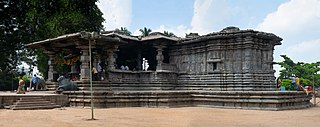
The Thousand Pillar Temple or Rudreswara Swamy Temple[ వేయి స్తంభాల గుడి]is a historic Hindu temple located in the town of Hanamakonda, Telangana State, India. It is dedicated to Lord Shiva, Vishnu and Surya. Thousand Pillar Temple, along with Warangal Fort, Kakatiya Kala Thoranam and Ramappa Temple are added to the tentative list of World Heritage sites recognised by UNESCO.
Annaram is a village in Thungathurthy mandal, Suryapet district, Telangana, India. Nearly 95% of population is literate.

Chandupatla is a historical village and Gram Panchayat of Nakrekal, Nalgonda District, Telangana state, India.
Thorrur is a revenue division, mandal and a municipality in Mahabubabad district of Telangana, India. It is located on Jayaprakash Narayana road between Warangal and Khammam. It is at about 50 km from Warangal, 62 km from Suryapet and 70 km from Khammam. It is a rapidly growing town due to its location.

Rudramadevi is a 2015 Indian Telugu-language 3D biographical action film based on the life of Rudrama Devi, one of the prominent rulers of the Kakatiya dynasty in the Deccan, and one of the few ruling queens in Indian history. The film written and directed by Gunasekhar features Anushka Shetty in a titular role as Rudramadevi, alongside an ensemble cast including Allu Arjun, Rana Daggubati, Vikramjeet Virk, Krishnam Raju, Prakash Raj, Suman, Nithya Menen, Adithya, and Catherine Tresa. The film is narrated by Chiranjeevi. The film's soundtrack and background score were composed by Ilaiyaraaja.

Warangal Fort is located in Warangal District, Telangana, India. It was the capital city of Kakatiya dynasty and Musunuri Nayakas. It appears to have existed since at least the 12th century when it was the capital of the Kakatiyas. The fort has four ornamental gates, known as Kakatiya Kala Thoranam, that originally formed the entrances to a now ruined great Shiva temple. The Kakatiyan arch has been adopted and officially incorporated into the emblem of Telangana after the bifurcation of Andhra Pradesh. The fort is included in the "tentative list" of UNESCO World Heritage Site and was submitted by the Permanent Delegation of India to UNESCO on 10/09/2010.
Madipally is a nearly 400-year-old village in the Mahabubabad district of the Indian state of telangana. It is 6 km from Thorrur, which is about 60 km from Warangal. It is 125 km from Hyderabad.
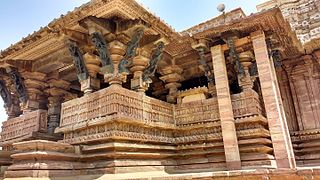
The earliest temples in Telangana include the Alampur Navabrahma Temples built during the 6th century CE by the Badami Chaulukyas.

Kakatiya Kala Thoranam is a historical arch in the Warangal district, of the Indian state of Telangana. The Warangal Fort has four ornamental gates which originally formed the gates to the destroyed great Shiva temple which are known as Kakatiya Kala Thoranam or Warangal Gates. The architectural feature of these historical arches of the Warangal Fort has been adopted as the symbol of the Kakatiya Dynasty and has been officially incorporated as the Emblem of Telangana for the state of Telangana.

The Culture of Telangana in India has a cultural history of about 5,000 years. The region emerged as the foremost centre of culture in Indian subcontinent during the rule of Kakatiyas, the Qutb Shahis and Asaf Jahi dynasties—. The rulers patronage and interest for culinery, arts and culture transformed Telangana into a multi-cultural region where two different cultures coexist together, thus making Telangana the representative of the Deccan Plateau and its heritage with Warangal and Hyderabad being its epicenter. Hyderabadi cuisine and Kakatiya architecture both from Telangana, are on the list of UNESCO creative city of gastronomy and UNESCO World Heritage Site. The regions major cultural events celebrated are "Kakatiya Festival" and Deccan Festival along with religious festivals Bonalu, Bathukamma, Dasara, Ugadi, Sankranthi, Milad un Nabi and Ramadan.

Warangal district, formerly Warangal Rural district, is a district in the Indian state of Telangana. The district shares boundaries with Mahabubabad, Jangaon, Hanamkonda, Mulugu and Bhupalpally districts.
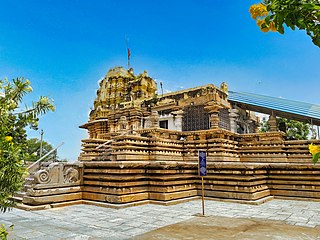
Erakeswara Temple is a Saivite Hindu temple located in the western side of Pillalamarri village, Suryapet district of Telangana, India. The temple was built on the banks of the Musi river in c. 1208 CE by Erakasani, the wife of Bēti Reddi of the Recherla family who were the feudatories of Kakatiyas. Erakeswara Temple is one among the four prominent and intricately carved stone and granite temples located in Pillalamarri village—the other three are about 250 metres east of the Erakeswara temple. These include the double temples next to each other: Parvati-Mahadeva Nameswara Temple and Trikuteshwara Temple ; and the third being the Chennakeshava Temple (Vishnu) in ruins that is a few hundred feet southwest of the double temples. They are all from 12th to early 13th century period.

Nameswara Temple, also known as Parvati Mahadeva Nameshwara temple, is a Saivite Hindu temple located in Pillalamarri, Suryapet district of Telangana, India. It is a double temple, with the Trikuteshwara temple (Alayam) aligned in parallel to it on the immediate north. The Nameshwara temple was constructed on the banks of the Musi river in c. 1202 CE by Nami Reddy of the Recherla family, who ruled this region and served as the feudatories of Kakatiyas. The genealogy of Nami Reddy is given in the inscription on the pillar.

Gaddam Padmaja Reddy is an Indian Kuchipudi exponent and music teacher. She performs ballets on mythological themes and contemporary social issues. She choreographed Kakatiyam, a Kuchipudi visual dance form. She was conferred with Kala Ratna in 2006, India's highest art award–Sangeet Natak Akademi Award in 2015 and Padma Shri, India's fourth highest civilian award, in the field of art for 2022.






